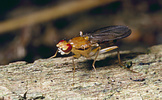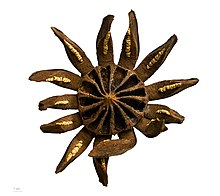You are here
Magnoliopsida
Clusia L.
EOL Text

Plate from Handlirsch (1884) showing wings of Clusia species: C. tigrina (figure 9), C. flava (figure 10)
Clusia Haliday (which now includes Paraclusia Czerny and Amuroclusia Mamaev (Lonsdale & Marshall, 2008)) occurs in the Holarctic and Oriental Regions and is comprised of 13 species. Several of these large, showy species are quite commonly encountered in North America and Europe, and consequently, have been discussed at length in the scientific literature over the past 150 years. The family name "Clusiidae" (spelled "Clusiinae" at the time) was even derived from the genus name containing the two frequently-collected European species, C. tigrina and C. flava, by Handlirsch in 1884 (see plate from original publication to right).
Adults are often found on a wide range of deciduous tree species (observations on conifers such as pine and spruce are much less frequent), preferring either stumps or dead, bare wood on standing trunks (Rohácek, 1995; Stubbs, 1982, personal obs.). Stubbs (1982) found adults of C. tigrina most often in August and September on barkless spots of live beech trees.
European Clusia have been reared from the stumps of several deciduous species such as beech, birch and elm (Perry & Stubbs, 1978; Smith, 1950), and have occasionally been reared from conifers (Soós, 1981). North American adults have been reared from 'moist wood', 'dead Populus tremuloides' and the 'cambium of dead maple'. Smith (1950) collected puparia of Clusia flava in a dry beech stump one inch from the surface in early April (emerged towards the end of the month).
Clusia czernyi and C. lateralis are found in northeast North America and C. occidentalis is found along the west coast from British Columbia to California. Clusia tigrina and C. flava are known from Europe, but C. flava is also known from Japan and likely occurs throughout the Palaearctic. Clusia sexlineata is found in Burma and the remaining species are known only from Japan (Sueyoshi, 2006).
| License | http://creativecommons.org/licenses/by-nc/3.0/ |
| Rights holder/Author | Steve Marshall, Owen Lonsdale, Tree of Life web project |
| Source | http://tolweb.org/Clusia/27675 |
Within the Clusiinae, reduced postverticals and a number of male-specific characters support a relationship between the predominantly Holarctic Clusia and the more southern Melanoclusia (Borneo) (Lonsdale & Marshall, 2008). These male characters are as follows: two rows of posteroventral bristles on the fore and mid femora (also found in the Chilean Clusiidae and Clusiodes), an inner-basal spur on a small, triangular surstylus, a uniquely-shaped pregonite (long, thin, minutely setulose along length and closely-associated with base of phallapodeme) and absence of the lateral lobes of the distiphallus (independently lost in some Sobarocephalinae and most Clusiodinae).
| License | http://creativecommons.org/licenses/by-nc/3.0/ |
| Rights holder/Author | Steve Marshall, Owen Lonsdale, Tree of Life web project |
| Source | http://tolweb.org/Clusia/27675 |
The synapomorphies currently used to define Clusia are as follows: one pair of interfrontal bristles; two pairs of stout lateral scutellar bristles that greatly exceed the apex of the scutellum (one pair sometimes lost); arista pubescent to short-plumose (not long-plumose); cross-vein dm-cu surrounded by wide infuscation (secondarily lost in several species); scutellum with central yellow stripe (sometimes expanded to include entire scutellum); epiphallus heavily sclerotized and produced anteriorly. Putative female genitalic characters include: ventral receptacle cylindrical; spermatheca dark (usually with dark reticulated pattern) excluding a small circular region around the point of attachment to the spermathecal duct.
| License | http://creativecommons.org/licenses/by-nc/3.0/ |
| Rights holder/Author | Steve Marshall, Owen Lonsdale, Tree of Life web project |
| Source | http://tolweb.org/Clusia/27675 |
Clusia was redefined by Lonsdale & Marshall (2008) to include the Palaearctic genera Paraclusia and Amuroclusia, which are now considered junior synonyms.
The relationships between the species of Clusia are not fully resolved although the basal position of C. tigrina is fairly certain. A revision of the genus is currently being developed.
| License | http://creativecommons.org/licenses/by-nc/3.0/ |
| Rights holder/Author | Steve Marshall, Owen Lonsdale, Tree of Life web project |
| Source | http://tolweb.org/Clusia/27675 |
Barcode of Life Data Systems (BOLDS) Stats
Public Records: 1
Specimens with Barcodes: 1
Species With Barcodes: 1
Clusia
Árboles, arbustos erectos, usualmente estranguladores o con menos frecuencia escandentes, dioicos, con abundante látex amarillento o crema. Hojas opuestas, usualmente pecioladas; láminas simples, gruesas, coriáceas. Flores unisexuales, actinomorfas, solitarias o en cimas terminales. Cáliz con 4-6 sépalos; corola de 4-9 pétalos libres; estambres numerosos, fértiles en las flores estaminadas, estériles (estaminodios) en las flores pistiladas, los filamentos usualmente unidos en la base; ovario súpero, con 4-12 carpelos, los óvulos numerosos, con placentación axial, el estigma peltado. Fruto una cápsula carnosa, dehiscente valvicida; semillas numerosas, con una cubierta carnosa rojiza. Género neotropical con alrededor de 150 especies.
Clusia
Trees or erect shrubs, usually stranglers or less frequently scandent, dioecious, with abundant yellowish or cream-colored latex. Leaves opposite, usually petiolate; blades simple, thick, coriaceous. Flowers unisexual, actinomorphic, solitary or in terminal cymes. Calyx of 4-6 sepals; corolla of 4-9 free petals; stamens numerous, fertile in the staminate flowers, sterile (staminodia) in the pistillate flowers, the filaments usually united at the base; ovary superior, with 4-12 carpels, the ovules numerous, with axile placentation, the stigma peltate. Fruit a fleshy capsule, valvicidally dehiscent; seeds numerous, with a fleshy, reddish covering. A neotropical genus of about 150 species.
Barcode of Life Data Systems (BOLD) Stats
Specimen Records:226
Specimens with Sequences:209
Specimens with Barcodes:41
Species:120
Species With Barcodes:117
Public Records:205
Public Species:116
Public BINs:0
Clusia is the type genus of the family Clusiaceae. Comprising 300-400 species, it is native to tropical America. The genus Clusia is named in honor of the botanist Carolus Clusius.
Description[edit]
Its species are shrubs, vines and small to medium-size trees up to 20 m tall, with evergreen foliage. Some species start life as epiphytes, then develop long roots that descend to the ground and eventually strangle and kill the host tree in a manner similar to strangler figs.
The leaves are opposite, 5–20 cm long and 2–10 cm broad, with a leathery texture and an entire margin. The flowers are white, cream, yellow, pink, red, blackish or green with 4-9 petals. The fruit is a leathery valvate capsule which splits open to release several red or orange, fleshy-coated seeds.
Clusia plants provide excellent nesting sites for some insects. For instance, Clusia grandiflora, a common species in Guianese forests, is an attractive place for Polistes pacificus wasps to build their paper nests because arboreal ants, which often prey on these wasps, do not normally reside in this species of tree.[1]
Selected species[edit]
- Clusia alata
- Clusia arborea
- Clusia carinata
- Clusia clarendonensis
- Clusia clusioides
- Clusia croatii
- Clusia cupulata
- Clusia fluminensis Planch. & Triana
- Clusia guttifera
- clusia grandiflora
- Clusia lanceolata
- Clusia longipetiolata
- Clusia major – Copey, Autograph Tree, Pitch-apple
- Clusia minutiflora
- Clusia osseocarpa
- Clusia palmicida
- Clusia plurivalvis
- Clusia polystigma
- Clusia portlandiana
- Clusia pseudomangle
- Clusia rosea – Scotch attorney, Autograph Tree, Pitch-apple
- Clusia skotaster
- Clusia spiritu-sanctensis
- Clusia tarmensis
- Clusia uvitana
- Clusia valerioi
Gallery[edit]
-
Autograph tree (C. rosea): leaf with autograph, flower, fresh fruit, and dried fruit.
-
Clusia lanceolata, Fairchild Tropical Botanic Garden
References[edit]
- ^ Corbara, Bruno et al. (2009). "Diversity and nest site selection of social wasps along Guianese forest edges: assessing the influence of arboreal ants". C.r. Biologies 332:470-479.
| License | http://creativecommons.org/licenses/by-sa/3.0/ |
| Rights holder/Author | Wikipedia |
| Source | http://en.wikipedia.org/w/index.php?title=Clusia&oldid=645012734 |







